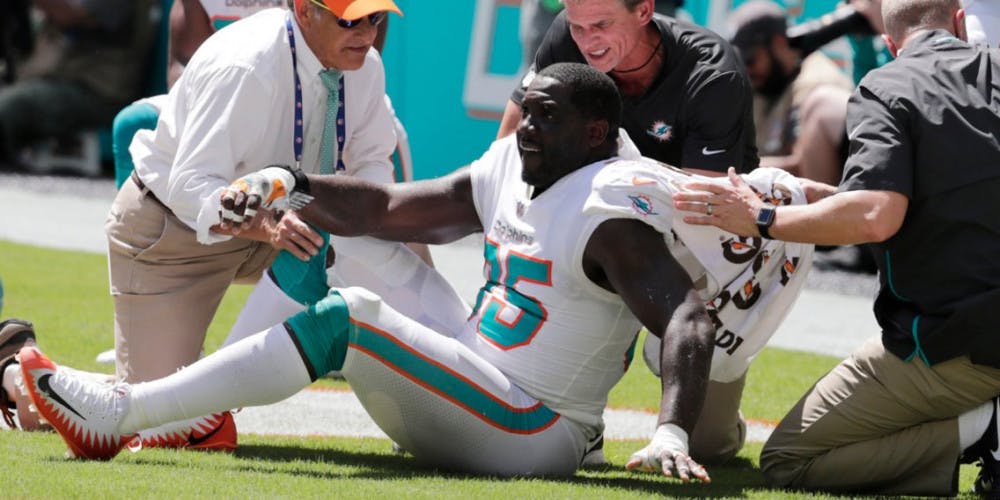Has the NFL gone too far in prioritizing the safety of its quarterbacks over that of its other players? Ask Miami Dolphins defensive end William Hayes and he’ll likely have a strong opinion on the subject.
Heading into Week 3, Hayes was a starting defensive end on an upstart Dolphins team that had jumped off to a 2-0 start. Not only was Hayes a starter, but he was also an integral part of Miami’s defense. Lining up opposite of Robert Quinn in the Dolphins 4-3 defensive front, Hayes had already recorded a sack and was on his way to many more before disaster struck against the Oakland Raiders.
In the third quarter, Hayes, who had already sacked Raiders quarterback Derrick Carr once, was on the prowl again. Closing in on his second sack of the afternoon, Hayes launched himself at Carr and made contact just as he let go of the ball. Hayes did not record the sack, but was credited with a quarterback hit and hurry. There was a catch, though.
Per the NFL’s new rule, a defensive player is not allowed to come down with his full body weight on the quarterback. Doing so results in a costly 15-yard personal foul penalty for unnecessary roughness. With this in mind, Hayes did his best to avoid coming down on Carr with his full 265-pound frame. While attempting to do this, Hayes planted his foot and his knee gave out. The end result was a season-ending torn ACL for the 11-year pro.
[caption id="attachment_24218" align="aligncenter" width="838"] Photo via NFL.com[/caption]
“His foot got caught in the ground,” Dolphins head coach Adam Gase said after the game. “It hurts. He was one of our leaders, one of our best guys in the locker room. It’s going to be a tough one for us to swallow.”
Gase was visibly angry while discussing the injury and it’s hard to blame him. If it weren’t for the NFL’s over-the-top rules to protect quarterbacks, Hayes would not have had to plant his knee in order to avoid making full contact with Carr. He could have finished the tackle as he was taught from a young age and avoided injury. Gase would still have his star defensive end and Hayes would have a healthy knee.
Quarterbacks deserve to be protected, but to what extent? Players are being forced to contort their bodies in ways that are not natural to avoid putting “full force” on quarterbacks. This is going to result in more injuries down the road, injuries that could have been avoided.
This rule came about after Green Bay Packers star quarterback Aaron Rodgers was slammed to the ground by Minnesota Vikings linebacker Anthony Barr in a game last year, fracturing Rodgers’ collarbone. Barr’s tackle put one of the game’s biggest stars out for an extended period of time and the NFL was not happy about this.
Similar to how the MLB took active measures to eliminate home plate collisions after San Francisco Giants catcher Buster Posey broke his leg in 2011, the NFL took steps they felt were necessary to eliminate excessive hits on quarterbacks. Once it happens to a star, the incident becomes magnified and rule makers move swiftly to ensure it never happens again.
These changes did not take into account the safety of other players. They are being forced to change the way they tackle and angle themselves in ways which are not natural when approaching a quarterback. Hopefully the league realizes this before it is too late, but it’s not likely.
As long as the quarterback, the main product of entertainment on the field, is healthy, the safety of opposing defenders will continue be swept under the rug until a star defender goes down.
Tyler Calvaruso can be reached at tyler.calvaruso@student.shu.edu or on Twitter @tyler_calvaruso
Photo via NFL.com[/caption]
“His foot got caught in the ground,” Dolphins head coach Adam Gase said after the game. “It hurts. He was one of our leaders, one of our best guys in the locker room. It’s going to be a tough one for us to swallow.”
Gase was visibly angry while discussing the injury and it’s hard to blame him. If it weren’t for the NFL’s over-the-top rules to protect quarterbacks, Hayes would not have had to plant his knee in order to avoid making full contact with Carr. He could have finished the tackle as he was taught from a young age and avoided injury. Gase would still have his star defensive end and Hayes would have a healthy knee.
Quarterbacks deserve to be protected, but to what extent? Players are being forced to contort their bodies in ways that are not natural to avoid putting “full force” on quarterbacks. This is going to result in more injuries down the road, injuries that could have been avoided.
This rule came about after Green Bay Packers star quarterback Aaron Rodgers was slammed to the ground by Minnesota Vikings linebacker Anthony Barr in a game last year, fracturing Rodgers’ collarbone. Barr’s tackle put one of the game’s biggest stars out for an extended period of time and the NFL was not happy about this.
Similar to how the MLB took active measures to eliminate home plate collisions after San Francisco Giants catcher Buster Posey broke his leg in 2011, the NFL took steps they felt were necessary to eliminate excessive hits on quarterbacks. Once it happens to a star, the incident becomes magnified and rule makers move swiftly to ensure it never happens again.
These changes did not take into account the safety of other players. They are being forced to change the way they tackle and angle themselves in ways which are not natural when approaching a quarterback. Hopefully the league realizes this before it is too late, but it’s not likely.
As long as the quarterback, the main product of entertainment on the field, is healthy, the safety of opposing defenders will continue be swept under the rug until a star defender goes down.
Tyler Calvaruso can be reached at tyler.calvaruso@student.shu.edu or on Twitter @tyler_calvaruso





